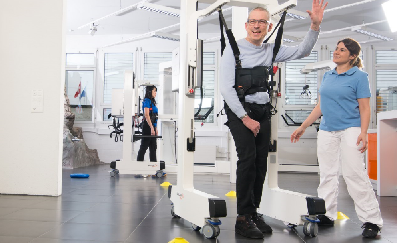Meeting the 2023 National Clinical Guideline for Stroke with the Andago
Hocoma
In this new blog series we’re taking a look at the National Clinical Guideline for Stroke, which defines recommended best practices within stroke care in the UK. This guideline provides much-needed updates to recommendations on rehabilitation, psychological and emotional support, and return to work services, amongst many other changes.
In light of these recommendations, we’re reviewing all our clinical solutions and sharing the ways in which these meet the 2023 guidelines. This is to help clinicians assess the rehabilitation technology we offer and how these devices can support patients recovering from a stroke, as well as support the stroke services offering this rehabilitation.
In today’s blog we’re looking at the Andago, a robotic body weight support system developed by Swiss manufacturer Hocoma.
Missed previous blogs? Take a look at how the Erigo, Lokomat, and ROBERT® meet the 2023 Stroke Guidelines.
About the Andago
The Andago is a robotic overground gait trainer that makes use of a dynamic bodyweight support and mobile robotic technology to actively follow a patient when training overground gait. The Andago‘s responsive body weight support system allows patients to move safely without the fear of falling, becoming unstable, or getting injured.
Patients can train in a safe and upright position, and take part in a variety of exercises, whilst freeing up therapists to increase efficiency. Clinicians can take a step back and assess the patient’s movement through a variety of gait, balance and stability tasks.
The Andago provides intensive, efficient and versatile gait and balance therapy for for patients requiring rehabilitation for any condition affecting their movement, and for fall prevention. Patients can perform repetitive, insensitive exercises and activities of daily living within the Andago either one-to-one, semi-supervised, or within a group.
Read more about the Hocoma Andago here.
Meeting the 2023 Stroke Guidelines
So how does the Andago robotic body weight support system meet the National Clinical Guideline For Stroke?
1. The Andago helps to provide 3 hours of multidisciplinary team therapy a day.
2. The Andago helps to deliver a range of individualised one-to-one therapy, structured semi-supervised practice, and group work.
3. The Andago supports the process of people who are mobile being assessed for real-world walking.
4. The Andago helps patients participate in balance and co-ordination work at least twice per week.
5. The Andago supports how people with weakness should be taught task-specific, repetitive, intensive exercises or activities to increase their strength.
6. The Andago supports how people with impaired balance after stroke should be offered repetitive task practice and balance training.
Get in touch with Summit Medical and Scientific today to discuss integrating the Andago into your clinical stroke practice.
About Summit Medical and Scientific
Summit Medical and Scientific are passionate about the power of rehabilitation technology.
We represent clinical technology leaders Hocoma, Motek and Life Science Robotics to provide the total solution for rehabilitation in the UK. Our partners have developed innovative therapy devices using robotics, sensors and virtual reality for early and acute rehabilitation, gait and balance therapy, arm and hand therapy, body weight support and more. View all of our clinical solutions here.
Get in touch with Summit Medical and Scientific today to find out more about incorporating state-of-the-art rehabilitation technology into your practice. You can contact us via email, phone (01372 459863) or our website contact page.
You can also follow us on Facebook, Twitter and LinkedIn, and subscribe to our newsletter for the latest updates.

